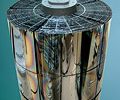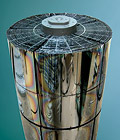X-rays actually allow for the invisible to be seen – an effect that astronomy also capitalizes on. Some planets, but also the surroundings of black holes, emit X-radiation. Observing it has proven to be rather difficult, however. After all, this radiation is absorbed by our atmosphere, which means it isn’t possible to use telescopes here on earth. The satellite-based Wolter Telescopes have made it possible to take a deeper look into the darkness of the universe.
With the Wolter Telescope, the electromagnetic radiation passes through a set of nested mirror shells. Due to the extremely flat angle of entry, the radiation is not absorbed, but rather reflected, and can then be guided onto the detector. This not only produces a two-dimensional image, but also measures the energy contained in the photons as they arrive. This type of spectroscopy allows for conclusions to be made on the interior atomic structure, temperature, as well as chemical and physical processes inside the field of view.
Glass mirrors expand the view
Researchers at DTU Space in Copenhagen (Denmark), Columbia University in New York (USA) and GSFC, Greenbelt (USA), have now created the prerequisites for much better images of the depths of the universe, thanks to a new technology. “New mirrors made of thermally formed, thin coated glass are our most important innovation,” says Finn Erland Christensen, Scientific Director of the Astrophysics Department at the DTU. “These can reflect X-radiation with ten times more energy than the telescopes currently being used at the NASA mission Chandra and ESA mission XMM-Newton. This provides us with a 100-fold increase in sensitivity in the hard X-ray band,” he adds.
For the telescope optics, Christensen and his team used mirror shells that consist of 0.21 millimeter thin glass from SCHOTT that is arranged in multiple layers. “Thin glass is light, flexible and stabile and can be thermally formed into near conical segments. Most importantly, however, it offers a much better surface structure than metal or plastic – the roughness is less than 5 atomic radii. This means we can coat these surfaces directly with the specialized X-ray reflecting multilayer structures which enable reflection in the hard X-ray band,” Christensen says.
Every nanometer counts in outer space
“The required tolerances were between 0.4 and a maximum of 0.6 nanometers. By comparison, the smallest structures that can be detected using a conventional light microscope are 200-500 nanometers in size. However, with an astronomical telescope mirror, stripes or waves only nanometers in size can result in too much distortion,” explains Oliver Jackl, product group head at SCHOTT Electronics & Biotech in Grünenplan (Germany). “Due to the continued further development of our drawing technique, we are able to guarantee surface roughness of less than 1 nanometer. This is really what makes new high-tech applications possible to begin with,” Jackl adds.
The thin glass “D 263 T” from SCHOTT was used to manufacture the mirror substrate. This is a colorless borosilicate glass with high chemical resistance. Thanks to a special manufacturing technique, this can have a thickness of between only 0.03 mm and 1.1 mm. The razor-thin glass is normally used for infrared filters in cameras, as a touch-sensitive panel in navigation instruments inside automobiles or as opto caps for laser diodes and opto-electronic sensors.
NuSTAR to map the universe
The new thin glass mirrors are installed on the NASA space probe NuSTAR that is scheduled to orbit the earth and map the distribution of black holes in the universe starting in 2011. NASA’s NuSTAR mission is managed by the Jet Propulsory Laboratory (JPL). Principal investigator is Prof. Fiona Harrison of the California Institute of Technology (Caltech) in Pasadena (USA).
NuSTAR consists of two X-ray telescopes that are aligned parallel. Observation takes place through Wolter Telescopes that are mounted onto an arm that can be extended to a focal length of ten meters. These concentrate the radiation onto two detectors that are found on the body of the satellite. From here, the images are transmitted down to earth. The improved technology of the telescopes continuously enables new discoveries. Whereas slightly more than 300 sources of X-ray radiation could be counted in the sky back in the 1970s, some 500,000 are known today.


